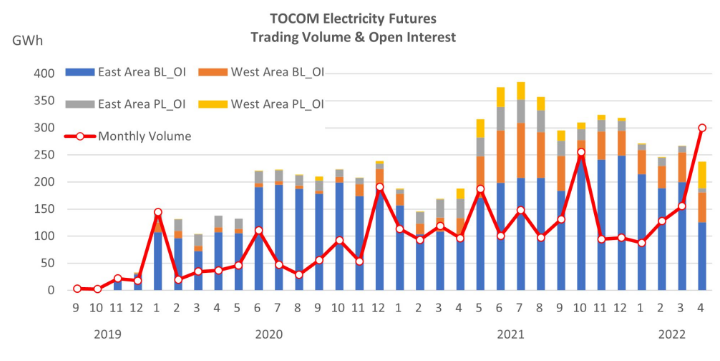TOCOM Energy
JPX Energy Market Updates(Jun. 20, 2022)
Welcome back to JPX energy market weekly updates. Price volatility over the last week has been acute for both gas and oil market.
As for the natural gas market, the news of an extended outage at the US Freeport LNG terminal and the Gazprom’s announcement of a further cut in the amount of gas it can pump through the Nord Stream 1 pipeline to Europe are the major issues last week, leaving the global gas market outside the US even more undersupplied than it already was.
On June 14, the announcement by the Freeport LNG terminal's operator showed that a resumption of partial operations is targeted to occur in approximately 90 days but a completion of all necessary repairs and a return to full plant operations is not expected until late 2022. Freeport LNG had initially said the facility would be offline for at least three weeks.
US LNG exports hit a record 9.7 bcf/d last year, according to the EIA. Freeport LNG is one of seven LNG export facilities currently operating in the United States. It provides around 17% of U.S. LNG export. Exports from the Freeport LNG terminal averaged 2.0 Bcf/d (56.6million cubic metres )from January to May 2022, compared with 1.8 Bcf/d (51million cubic metres ) during the same period last year and an annual average of 1.9 Bcf/d (53.8 million cubic metres )in 2021. Freeport has been operating at high utilization rates this year because of strong demand from Europe. Almost three-quarters of LNG exports from Freeport were shipped to Europe during the first five months of this year, compared with 29% on average during 2021. Higher spot natural gas prices at the European trading hubs incentivized global LNG market participants with destination flexibility to deliver more LNG supplies to Europe, however the wide difference between TTF and Henry Hub reflects logistical constraints on both sides of the Atlantic, that is there is insufficient liquefaction capacity to meet growing export demand in the US, while in Europe there is insufficient regasification capacity.
As for the European market, Russia's Gazprom has announced a further cut in the amount of gas it can pump through the Nord Stream 1 pipeline to Europe. The second supply capacity cut in as many days means that Nord Stream 1 will run at just 40 per cent of its capacity. Now gas supplies via the Nord Stream gas pipeline can currently be provided in the amount of up to 67 million cubic metres per day while the expected volume is 167 million cubic meters per day. Gazprom also told Italian gas giant Eni that it would reduce gas through a different pipeline by roughly 15% on Wednesday.
These supply disruptions have sent shockwaves through the global gas market with US HH prices falling about 20% and prices in Europe and Asia climbing more than 30% in reaction. Asian LNG spot prices or the Platts JKM for August delivery breached the $38/ million British Thermal Units mark on June 16, and was last traded around $34 with Dutch TTF price climbing from 83 to around 124 euro per megawatt hour. JPX LNG (Platts JKM) Futures for contract for august was last settled around 31$/MMBtu.
In terms of price volatility, JKM LNG prices have risen even more. Despite a lack of significant volumes flowing from the Asia Pacific to Europe with arbitrage window now closed, the outages in the Atlantic basin certainly have a ripple impact on Asia. With Russian pipeline supplies falling, European demand for spot LNG cargo is likely to remain strong, and the freeport outage extension is likely to force Northeast Asian term buyers to seek alternative spot cargo to meet summer restock demand. European gas and Asian LNG prices is likely to remain tightly correlated until demand is finally shut off by high prices. Most market participants support the view that JKM prices are likely to be particularly volatile during the second half of this year. So the JPX LNG contract would be a good tool to hedge against fluctuations in spot prices settled on a monthly average basis.
In the oil market, crude futures traded sharply lower on Friday after the US announced a 75 basis point hike in its target interest rate. Even though economic slow down fears persist, the broader downward price pressures were mitigated by tighter prompt oil product market balances, reinforcing the need to maximize refinery throughputs. From a longer term, world oil demand is projected to surpass pre-pandemic levels this year and next year according to OPEC and IEA’s latest OMR released last week. Among the product plate, demand growth is supported by the recovery in jet kerosene demand and the petrochemical feedstocks LPG and naphtha, notably in China, the US and India. While advanced economies in western countries are underpinning oil demand growth this year, much of apparent demand growth might result from a robust recovery in Asia demand. Last week, the spread between JPX Dubai and ICE Brent witnessed a quick rebound from recent low levels because report of Libya’s production recovery, and the spread may find its support level during this year's volatility if Asian demand continues to recover.






